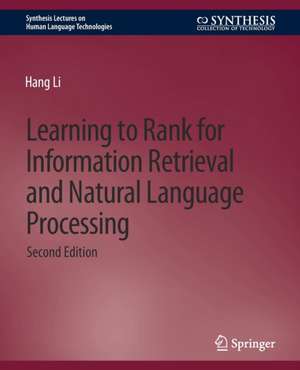Learning to Rank for Information Retrieval and Natural Language Processing, Second Edition: Synthesis Lectures on Human Language Technologies
Autor Hang Lien Limba Engleză Paperback – 5 noi 2014
Din seria Synthesis Lectures on Human Language Technologies
- 20%
 Preț: 223.34 lei
Preț: 223.34 lei - 20%
 Preț: 282.54 lei
Preț: 282.54 lei - 20%
 Preț: 277.60 lei
Preț: 277.60 lei - 20%
 Preț: 227.81 lei
Preț: 227.81 lei - 20%
 Preț: 227.29 lei
Preț: 227.29 lei - 20%
 Preț: 227.12 lei
Preț: 227.12 lei - 20%
 Preț: 274.48 lei
Preț: 274.48 lei - 20%
 Preț: 479.30 lei
Preț: 479.30 lei - 20%
 Preț: 224.65 lei
Preț: 224.65 lei - 20%
 Preț: 415.47 lei
Preț: 415.47 lei - 20%
 Preț: 357.06 lei
Preț: 357.06 lei - 20%
 Preț: 388.17 lei
Preț: 388.17 lei - 20%
 Preț: 226.64 lei
Preț: 226.64 lei - 20%
 Preț: 478.36 lei
Preț: 478.36 lei - 20%
 Preț: 334.38 lei
Preț: 334.38 lei - 20%
 Preț: 225.99 lei
Preț: 225.99 lei - 20%
 Preț: 225.67 lei
Preț: 225.67 lei - 20%
 Preț: 166.43 lei
Preț: 166.43 lei - 20%
 Preț: 424.05 lei
Preț: 424.05 lei - 20%
 Preț: 358.95 lei
Preț: 358.95 lei - 20%
 Preț: 225.67 lei
Preț: 225.67 lei - 20%
 Preț: 227.12 lei
Preț: 227.12 lei - 20%
 Preț: 270.04 lei
Preț: 270.04 lei - 20%
 Preț: 537.06 lei
Preț: 537.06 lei - 20%
 Preț: 225.67 lei
Preț: 225.67 lei - 20%
 Preț: 228.13 lei
Preț: 228.13 lei - 20%
 Preț: 353.61 lei
Preț: 353.61 lei - 20%
 Preț: 227.12 lei
Preț: 227.12 lei - 20%
 Preț: 422.25 lei
Preț: 422.25 lei - 20%
 Preț: 270.69 lei
Preț: 270.69 lei - 20%
 Preț: 354.92 lei
Preț: 354.92 lei - 15%
 Preț: 519.19 lei
Preț: 519.19 lei - 20%
 Preț: 226.97 lei
Preț: 226.97 lei - 20%
 Preț: 384.53 lei
Preț: 384.53 lei - 20%
 Preț: 226.64 lei
Preț: 226.64 lei - 20%
 Preț: 503.01 lei
Preț: 503.01 lei - 20%
 Preț: 358.04 lei
Preț: 358.04 lei - 20%
 Preț: 330.75 lei
Preț: 330.75 lei - 20%
 Preț: 327.95 lei
Preț: 327.95 lei - 20%
 Preț: 299.48 lei
Preț: 299.48 lei - 20%
 Preț: 228.28 lei
Preț: 228.28 lei - 20%
 Preț: 382.39 lei
Preț: 382.39 lei - 20%
 Preț: 418.59 lei
Preț: 418.59 lei - 20%
 Preț: 326.13 lei
Preț: 326.13 lei - 20%
 Preț: 271.86 lei
Preț: 271.86 lei
Preț: 224.50 lei
Preț vechi: 280.62 lei
-20% Nou
Puncte Express: 337
Preț estimativ în valută:
42.96€ • 46.65$ • 36.09£
42.96€ • 46.65$ • 36.09£
Carte tipărită la comandă
Livrare economică 22 aprilie-06 mai
Preluare comenzi: 021 569.72.76
Specificații
ISBN-13: 9783031010279
ISBN-10: 3031010272
Ilustrații: XIII, 107 p.
Dimensiuni: 191 x 235 mm
Greutate: 0.23 kg
Ediția:2
Editura: Springer International Publishing
Colecția Springer
Seria Synthesis Lectures on Human Language Technologies
Locul publicării:Cham, Switzerland
ISBN-10: 3031010272
Ilustrații: XIII, 107 p.
Dimensiuni: 191 x 235 mm
Greutate: 0.23 kg
Ediția:2
Editura: Springer International Publishing
Colecția Springer
Seria Synthesis Lectures on Human Language Technologies
Locul publicării:Cham, Switzerland
Cuprins
Learning to Rank.- Learning for Ranking Creation.- Learning for Ranking Aggregation.- Methods of Learning to Rank.- Applications of Learning to Rank.- Theory of Learning to Rank.- Ongoing and Future Work .
Notă biografică
Hang Li is chief scientist of the Noahs Ark Lab of Huawei Technologies. He is also adjunct professor at Peking University, Nanjing University, Xian Jiaotong University, and Nankai University. His research areas include information retrieval, natural language processing, statistical machine learning, and data mining. He graduated from Kyoto University in 1988 and earned his PhD from the University of Tokyo in 1998. He worked at the NEC lab in Japan during 1991 and 2001. He joined Microsoft Research Asia in 2001 and has been working there until present. Hang has about 100 publications at top international journals and conferences, including SIGIR, WWW, WSDM, ACL, EMNLP, ICML, NIPS, and SIGKDD. He and his colleagues papers received the SIGKDD08 best application paper award and the SIGIR08 best student paper award. Hang has also been working on the development of several products. These include Microsoft SQL Server 2005, Microsoft Office 2007 and Office 2010, Microsoft Live Search 2008, Microsoft Bing 2009 and Bing 2010. He has also been very active in the research communities and served or is serving the top conferences and journals. For example, in 2011, he is PC co-chair of WSDM11; area chairs of SIGIR11, AAAI11, NIPS11; PC members of WWW11, ACL-HLT11, SIGKDD11, ICDM11, EMNLP11; and an editorial board member on both the Journal of the American Society for Information Science and the Journal of Computer Science & Technology.
